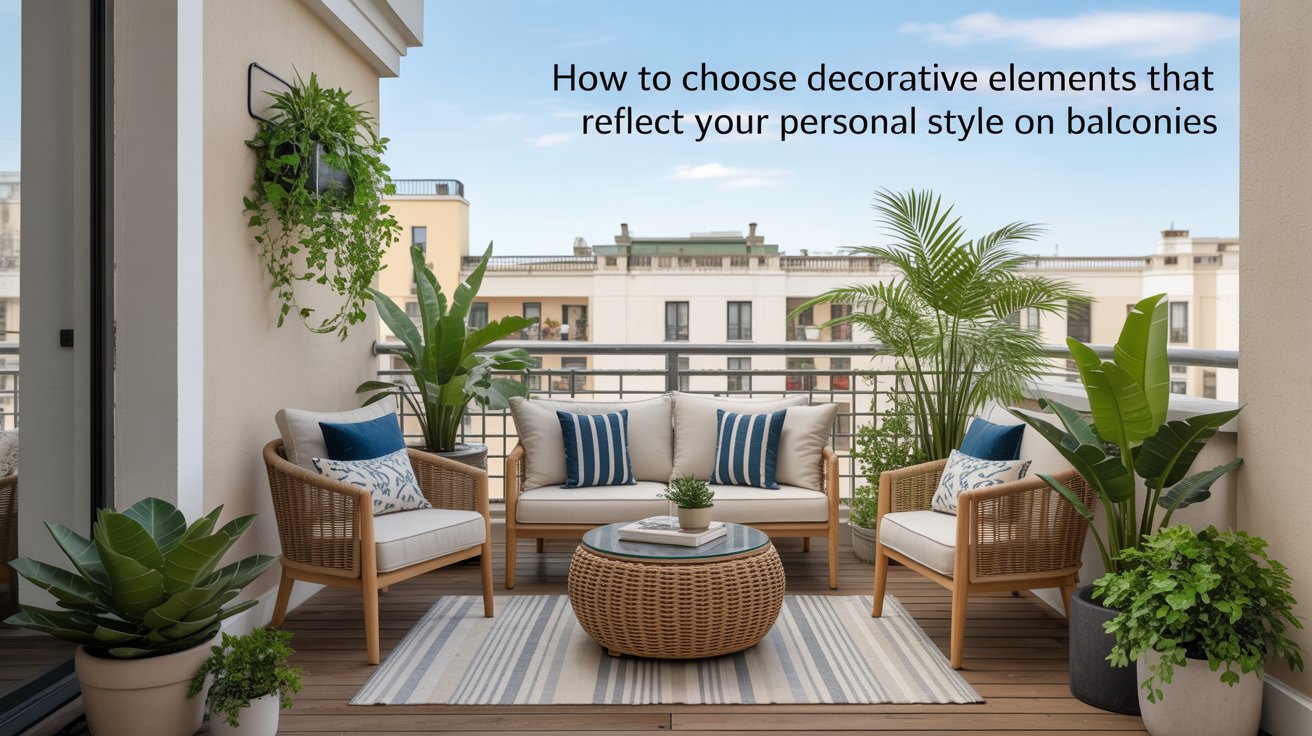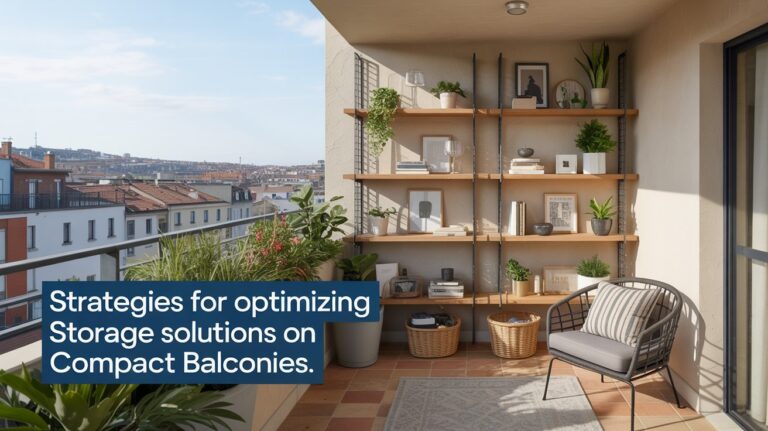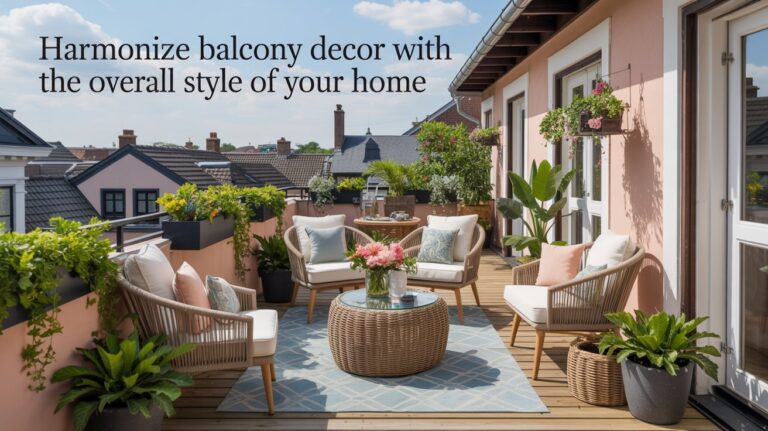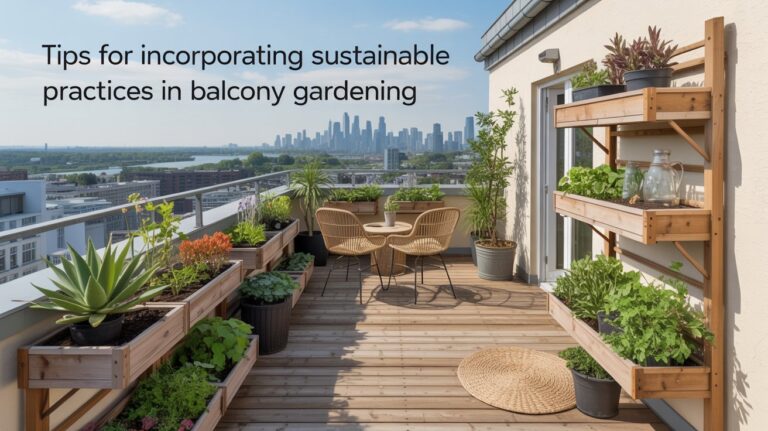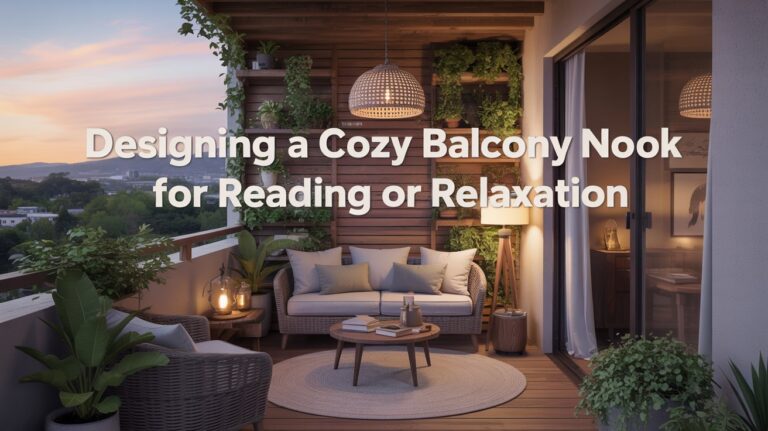How to Choose Decorative Elements That Reflect Your Personal Style on Balconies
I have been, or can be if you click on a link and make a purchase, compensated via a cash payment, gift, or something else of value for writing this post. As an Amazon Associate, I earn from qualifying purchases. Please read my full Affiliate Disclosure for more information.
Choose anchor colors that feel like you—think mood, not just hue. Pair them with textures that speak your climate and habits: rugged timber, smooth ceramics, lush greenery, soft textiles. Layer plants, fabrics, and surfaces to tell your story, then balance warm and cool tones so the balcony stays cohesive. Pick weather-ready furniture that fits your rhythm and can rearrange easily. Create cozy zones with seating and lighting, and sprinkle personal mementos without clutter. If you want more, you’ll uncover deeper steps next.
Key Takeaways
- Identify preferred outfits, textures, and moods to guide balcony decor choices and ensure cohesive style.
- Use color psychology to evoke your vibe, balancing warm and cool tones for calm, inviting spaces.
- Mix weatherproof materials (teak, aluminum, resin) with tactile textiles to layer texture and durability.
- Create modular, flexible zones with movable planters and furniture for easy seasonal updates.
- Layer lighting and focal points (plants, rugs, tables) to reflect your personality and enhance ambiance.
Understanding Your Personal Style for Balcony Decor
Understanding your personal style is the first step to balcony decor that feels truly yours. You’ll translate preferences into spaces you inhabit daily, so start by noting what outfits, textures, and moods you naturally choose. Color psychology guides how you feel in small moments—calm blues for serene mornings, warm terracottas for lively evenings, or muted greens for quiet retreats. Seek style consistency across elements: railing, textiles, planters, and lighting should echo a unifying vibe. Avoid overcomplication; clarity arises from deliberate choices. Your balcony becomes cohesive, expressive, and functional when intent, taste, and comfort align with your everyday habits.
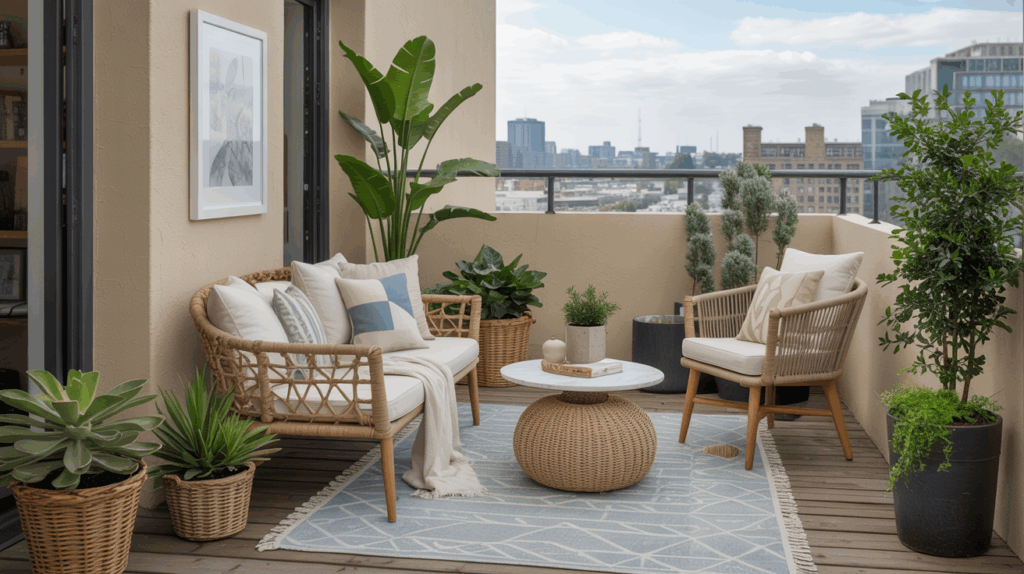
Defining Anchor Colors That Tie Your Space Together
Your personal style gave you a map, and now anchor colors act as the compass that keeps every piece speaking the same language. You choose anchor tones thoughtfully, then let color coordination guide accessories and furniture. Start with a dominant hue that reflects your vibe, then introduce complementary shades as accents. Balance warm and cool tones to avoid visual conflict, and guarantee contrast supports readability from arbors and seating areas. Use accent shading to highlight focal points—plants, artwork, or railings—without overpowering the scene. This approach creates coherence, depth, and a calm balcony you can enjoy daily.
Layering Textures: Plants, Fabrics, and Surfaces
Layering textures on a balcony is all about balance: plants, fabrics, and surfaces should weave together without competing for attention. You’ll create harmony by pairing lush greenery with tactile textiles and thoughtful surfacing. Prioritize contrast in texture: soft textiles against rough stone, glossy pots beside matte planters, airy fabrics near solid panels. Let texture layering guide focal points—a statement plant rack, a woven rug, a weathered tabletop. Consider surface mixing: pair materials that age gracefully together, then anchor with a recurring color. This approach keeps your balcony feeling cohesive, tactile, and inviting without visual clutter.
Selecting Weather-Resistant Furniture That Fits Your Rhythm
Balcony charm hinges on furniture that stands up to the elements without stealing the scene. You’ll choose weatherproof furniture that resists sun, rain, and humidity while matching your rhythm. Prioritize materials that endure—teak, aluminum, resin, or powder-coated steel—and check coatings for UV stability. Opt for stylish outdoor seating that folds, stacks, or nests when space shifts, so your balcony remains flexible. Consider cushions with quick-dry foam and water-repellent fabric; store them during storms. Measure пространство, balance weight with stability, and ensure easy maintenance. Your rhythm guides placement, not fragility, ensuring lasting function and refined, practical charm.
Creating Cozy Zones: Seating, Lighting, and Flow
Carefully group seating, lighting, and movement to craft inviting zones that feel intimate yet open. You create cozy corners by pairing compact seating with soft, warm lighting and clear sightlines. Choose plant arrangements that frame views without crowding, and vary heights to add depth. Use color schemes to anchor moods: cool neutrals for calm, warm accents for energy, and subtle patterns for texture. Guarantee flow by leaving clear paths and alternating seating angles so conversations unfold naturally. Balance focal points with negative space, letting each zone breathe. Your balcony becomes a versatile retreat, adaptable from morning coffee to twilight chats.
Mixing Eras and Patterns to Reflect Your Story
Textures and eras can tell your balcony story as clearly as any photo wall—mix vintage and modern elements with intention to reflect who you are, not just what’s trendy. You’ll blend vintage accents with contemporary pieces, balancing textures, colors, and scale so nothing feels random. Practice pattern mixing by repeating a motif in cushions, picks, and rugs, then echo it with a solid backdrop to avoid chaos. Be intentional about provenance: pair heirloom touches with sleek metal or glass for contrast. This approach creates a cohesive narrative, inviting curiosity while keeping practical durability and daily use in mind.
Incorporating Personal Mementos Without Clutter
You can highlight personal mementos on a balcony without crowding the space by choosing a few meaningful pieces and arranging them as a quiet display. Focus on minimalist keepsakes that tell your story through color, texture, and placement, not volume. Let each item breathe, and keep the overall vibe unified and intentional.
Display Personal Mementos
Personal mementos can warm a balcony, but they should whisper rather than shout. You display them with intention, not abundance, pairing each piece to a purpose. Choose a focal item and arrange smaller tokens around it so your space breathes. Use vintage accents to hint at memory without crowding surfaces. Group items in small clusters to create visual rhythm, avoiding random scatter. Maintain color coordination by sticking to a limited palette that ties mementos to your balcony’s overall tone. Rotate pieces seasonally to refresh the scene without clutter. Your balcony feels personal, calm, and thoughtfully curated.
Minimalist Keepsakes Display
Balancing memory with space, a minimalist keepsake display embraces personal meaning without crowding the balcony. You curate a few items that matter, selecting size, texture, and resonance over quantity. Treat each piece as an artistic focal point, intentionally placed to command attention without shouting. Use color coordination to unite disparate mementos—choose a neutral backdrop and pull in one or two accent hues to guide the eye. Keep surfaces clean and limited, letting negative space breathe. Rotate seasonal tokens sparingly to refresh the scene, ensuring balance between sentiment and decluttered design that supports daily outdoor living.
Balancing Functionality With Aesthetic Appeal
To balance functionality with aesthetic appeal, you’ll prioritize Practical Flair that serves daily use without sacrificing style. Think Space-Saving Aesthetics, choosing compact, multi-purpose pieces that still feel intentional and inviting. Aim for Material Harmony Tips—textures, tones, and finishes that unite usefulness with visual calm.
Practical Flair Balance
Balcony décor should be as practical as it is pretty, so you’re not choosing between function and flair—you’re blending them. You’ll pair sturdy, weatherproof furniture with cushions in durable fabrics, prioritizing comfort without clutter. Use artistic lighting to extend usability after sundown, selecting fixtures that emit gentle, glare-free glow. Plan color coordination that ties planters, textiles, and accessories into a cohesive palette, simplifying maintenance and visual rhythm. Choose multi-purpose pieces, like storage benches or foldable tables, to reduce space strain. Keep pathways clear, lines simple, and accents intentional, ensuring every element serves daily life while elevating mood and style.
Space-Saving Aesthetics
Here’s how to fuse form and function on a small balcony: think vertical, multi-use, and intentionally uncluttered, so every inch earns a purpose without cramping your style.
- Use wall shelves and hanging planters to free floor space
- Choose artificial plants for year-round greenery with minimal upkeep
- Integrate decorative sculptures as focal points without crowding
- Opt compact furniture that folds or nests when not in use
This approach preserves airflow and light while highlighting personality. Focus on simple silhouettes, cohesive color, and purposeful placement to balance aesthetics with practicality. Your balcony becomes an elegant, efficient extension of your living space.
Material Harmony Tips
Texture and tone should work in concert, so your balcony feels unified rather than patched together. Material harmony means balancing forms, finishes, and durability without sacrificing personality. Begin with color coordination that ties planters, furniture, and surfaces into a cohesive palette. Choose material textures that complement each other—smooth ceramics with woven fabrics, matte metals with glossy woods—so contrasts feel intentional, not random. Prioritize weather resistance and cleaning ease, then test Scale and proportion to avoid visual clutter. Finally, allow one soft accent to echo accent colors elsewhere in your space, reinforcing unity while preserving character.
Lighting Strategies for Day and Night Ambiance
When you’re shaping day and night ambiance, lighting should be both functional and flattering, guiding movement by day and inviting warmth after dusk.
- Use solar powered lights for easy, eco-friendly daytime charging and subtle glow after sunset
- Create balanced string light arrangements to define edges and add whimsy
- Layer lighting: wall washers or floor lamps for task areas, fairy lights for ambience
- Choose dimmable options to shift mood without changing fixtures
This approach keeps spaces practical yet intimate, blending safety with style while showcasing personal taste.
Practical Tips for Moving and Reconfiguring Your Balcony Decor
You’ll start with moveable layout tricks that let you reconfigure each season in minutes. Next, consider reconfiguring seasonal layers to shift mood without buying new pieces. Finally, plan space-saving placements that maximize balance and flow without crowding your balcony.
Moveable Layout Tricks
If you want a balcony that stays fresh without a full makeover, start with flexible layouts you can tweak in minutes. Moveable tricks keep your space dynamic and inviting, so you’ll feel new without buying more. Think modular furniture, lightweight planters, and stackable stools that chill or shift on a whim. Use zones that swap as your mood shifts, and align pieces with color coordination for coherence. Let artistic accents pop in focal spots to anchor the eye.
- Swap cushions to reinvent mood
- Foldaway furniture for easy reconfiguration
- Lightweight planters on rolling carts
- Magnetic wall organizers for quick rearrangement
Reconfiguring Seasonal Layers
Seasonal layers aren’t about a full swap so much as a smart, stepwise reweaving: you add or shed textures, colors, and gear in tune with the changing weather and moods. Reconfiguring seasonal layers means you test small changes first: swap a throw, adjust planter heights, or relocate seating for sun versus shade. Use reconfiguration strategies to map mood shifts—coolers textures for mornings, warmer accents for evenings. Keep a simple kit: lightweight fabrics, compact lighting, weatherproof accessories. Document what works, then repeat. This iterative approach preserves coherence, minimizes clutter, and lets your balcony evolve with the seasons.
Space-Saving Placement Plans
Small tweaks matter: start with a quick audit of every inch, then sketch a simple plan that prioritizes flexibility. You’ll move pieces like garden sculptures and decorative wall panels to test sightlines, avoid crowding, and reveal open space. Keep height variety low and platforms modular to reconfigure quickly. Assign zones for seating, plants, and display, then swap elements by season without clutter. Prioritize multi-use items and wall-mounted focal points to free floor space. Plan easy access to outlets and drainage. Align colors and textures for cohesion.
- Audit, reorient, and log in a single plan
- Use modular units and wall mounts
- Rotate accents seasonally
- Create flexible seating arrays
Conclusion
You’ve mapped your vibe across color, textures, and tiny rituals, and your balcony finally speaks your language. Embrace anchor hues that anchor every module, layer greens with fabrics that breathe, and pick weather-smart furniture that moves with your day. Create cozy zones, sprinkle personal mementos without clutter, and let light guide mood from sunlit to starlit. Stay flexible, rearrange as needed, and let function flirt with beauty, so every step outside feels like you stepping into yourself.
